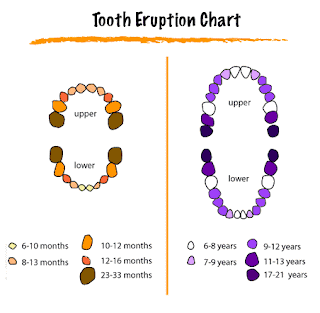Tooth Eruption Schedule For A Child
Knowing when a child’s tooth is going to fall out is equally important to when teeth will start to come in. Knowing your child’s tooth schedule will help you better prepare for when your child starts teething and ultimately losing their teeth.
A child’s tooth will fall out in the same order that they arrived. The lower central incisors (the two teeth in the lower front of the mouth) are the first to arrive between 4-7 months old. The upper incisors will be the next to come in and are located directly above the lower incisors. You will begin to see these erupt between 8-12 months old. The upper lateral incisors will appear between 9-13 months, at this point your child will have four teeth on the top and two on the bottom. There is some overlap with the lower lateral incisors as they will erupt between 10-16 months old. The upper molars (the teeth in the back of the mouth used predominantly for chewing) will arrive between 14-19 months, their counterparts (the lower molars) will arrive between 14-18 months old. The upper canines also called cuspids (the teeth between the molars and the incisors) are the second to last pair of teeth to erupt at around 16-22 months with the lower ones 17-23 months. Finally, the upper second molars arrive and are the last teeth to erupt. Generally, by age three a child will have 20 primary teeth. The permeant teeth will take a lot longer to come in with the last ones erupting between 12-13 and the wisdom teeth (although not everyone has wisdom teeth) between 17-21 years of age.
Caring for baby teeth are just as important as adult teeth. The ADA recommends using fluoride toothpaste on children’s teeth starting at age two. Simply putting a little on your finger and rubbing it on their teeth will suffice until their first dental appointment when a fluoride wash can be used. The fluoride will remineralize the tooth and make it more resilient to cavities. Another procedure to provide additional protection for your teeth is to use a sealant from your dentist. Sealants are put on the back teeth and provide a barrier against food particles and bacteria causing tooth decay.
Jackson Family Dentistry is committed to oral health and part of that commitment is educating our patients. Understanding how teeth function especially children’s teeth will help their oral health for years to come. Having a timely dental check-up will also allow the dentist to monitor the development of your child’s teeth and help keep them cavity-free from an early age. If you have any questions, feel free to call our office or visit our website for more information.


Comments
Post a Comment